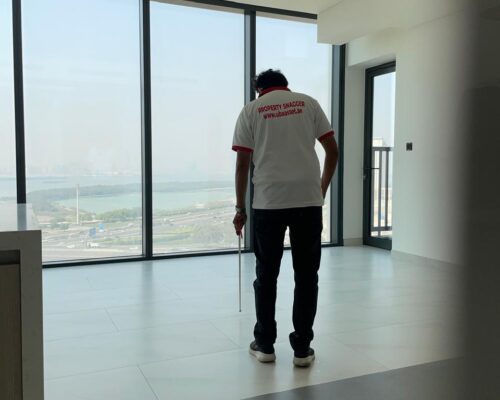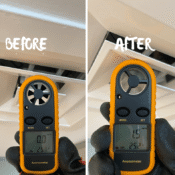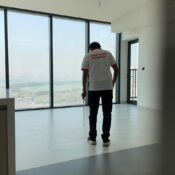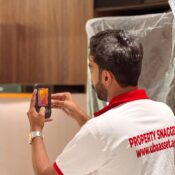How Many Hollow Tiles are Acceptable in Dubai Construction?

Buying property in Dubai is an exciting milestone, but construction quality often becomes a major concern for buyers. One of the most common defects found during property snagging is hollow tiles.
When you tap a tile and hear a hollow sound, it usually means there isn’t enough adhesive underneath. This raises an important question for homeowners and investors: how many hollow tiles are acceptable in Dubai construction?
We will guide you on what hollow tiles are and why they happen. And also break down based on international standards, local practices, and what you should look out for.
What Are Hollow Tiles and Why Do They Happen?
A hollow tile is a tile that sounds empty or hollow when tapped because of poor bonding with the surface below.
Common causes of hollow tiles include:
- Insufficient adhesive was applied during installation
- Air gaps left under tiles due to poor quality
- Shortcuts taken during construction to save time or materials
- Movement of the floor slab leading to gaps under tiles
Why are they a problem?
- Hollow tiles are weaker and more likely to crack or break.
- Wet areas like bathrooms or balconies can lead to water leakage and mold.
- Over time, hollow tiles may pop up or debond completely, leaving you with costly repairs.
International Standards for Hollow Tiles
Certain standards guide construction quality around the world. Here’s what they say about tile voids:
BS 5385 (UK Standard for Wall & Floor Tiling) – Localized voids beneath tiles are permitted, but not more than 20% of the tile area. For heavy-traffic floor areas, voids should be less than 10%.
ANSI A108 (American Standard for Tiling) – Requires 80–90% adhesive coverage under tiles, depending on location. In dry indoor areas, at least 80% coverage is required, meaning up to 20% hollow is acceptable. In wet areas, exteriors, or heavy-traffic zones, at least 95% coverage is needed, so only up to 5% hollow is acceptable.
In simple terms: Normal floors can tolerate up to 20% hollow tiles, but wet or high-traffic areas should have no more than 5–10%. For luxury or premium finishes, hollow tiles are ideally not acceptable at all.
Acceptable Hollow Tile Percentage in Dubai Construction
Dubai follows international best practices in construction, but in reality, snagging inspections often reveal hollow tiles.
Here’s a practical breakdown of what’s considered acceptable in Dubai:
- Dry areas like bedrooms and living rooms, with up to 20% hollow tiles, may be tolerated.
- Wet areas like bathrooms, kitchens, and balconies have only 5–10% hollow tiles that are acceptable.
- In Luxury properties/premium finishes, hollow tiles are usually not acceptable at all.
This means that while small percentages might be tolerated, you should never ignore hollow tiles, especially in wet areas.
Why You Shouldn’t Ignore Hollow Tiles
Hollow tiles may not look dangerous at first, but the risks increase over time:
- Structural risk: They can crack or lift under pressure.
- Water damage: In bathrooms or kitchens, water can seep in, causing leaks and mold.
- High repair costs: Replacing tiles after handover is far more expensive than fixing them before moving in.
That’s why professional snagging inspections in Dubai always check for hollow tiles during handover.
How UBA Snagging Helps You Detect Hollow Tiles
At UBA Snagging & Asset Management, our certified inspectors use advanced tools and methods to detect hollow tiles during property inspections.
- We follow RERA regulations and international standards (InterNACHI certified).
- Our detailed inspection reports highlight tile defects, cracks, leaks, and poor quality.
- Reports are delivered within 12–23 hours so that you can raise issues with your developer immediately.
By identifying hollow tiles early, you can get them repaired before signing the handover, saving you time, stress, and thousands of dirhams.
Conclusion
So, how many hollow tiles are acceptable in Dubai construction?
- Up to 20% in dry areas
- 5–10% maximum in wet areas
- 0% preferred in premium finishes
While small percentages are tolerated, even one hollow tile in the wrong place can cause long-term damage. That’s why booking a professional snagging inspection is the safest choice for property buyers in Dubai.
Book your certified snagging inspection in Dubai today with UBA.
Call/Whatsapp +971 562686549
All Categories
Recent Posts
How Many Hollow Tiles are Acceptable in Dubai Construction?
Common Snagging Issues Found in Dubai Properties
Have questions? Feel free to write us
Call expert
+971 562686549
Write email
hello@ubaasset.ae
Visit office
Port Saeed, NGI House - Office no 403-70 Street, Deira, Dubai, United Arab Emirates




